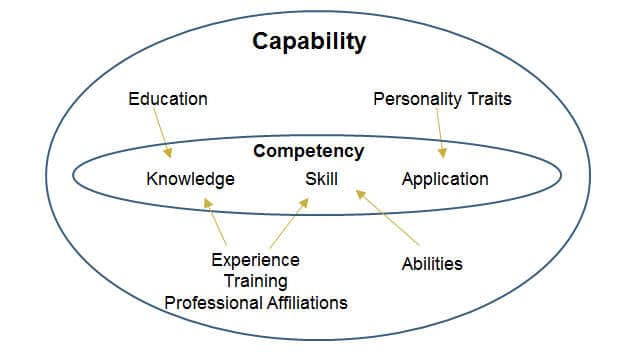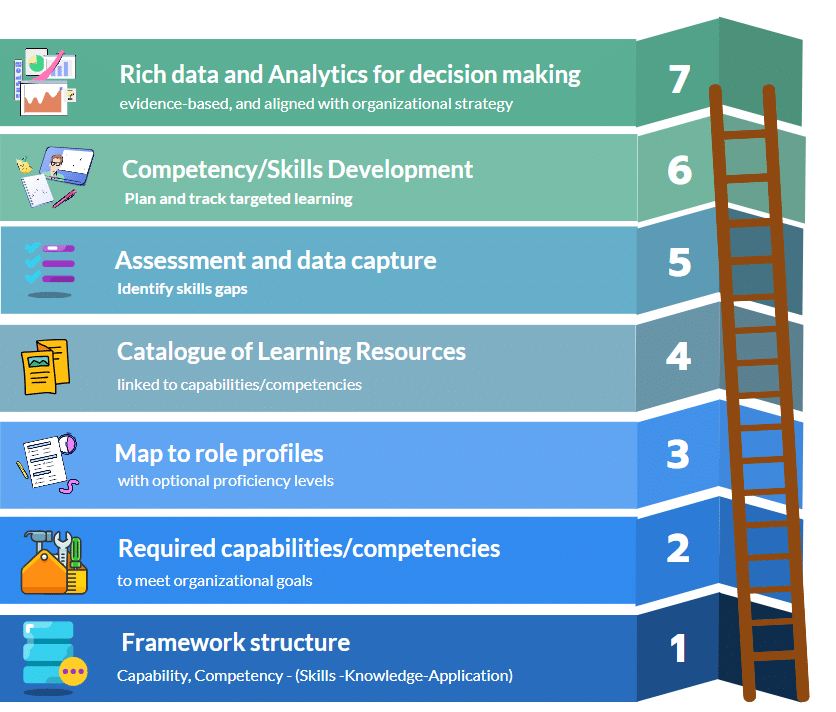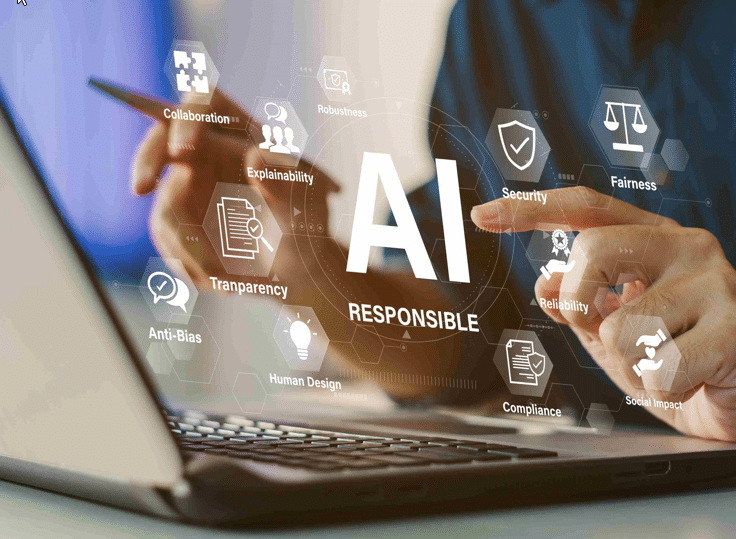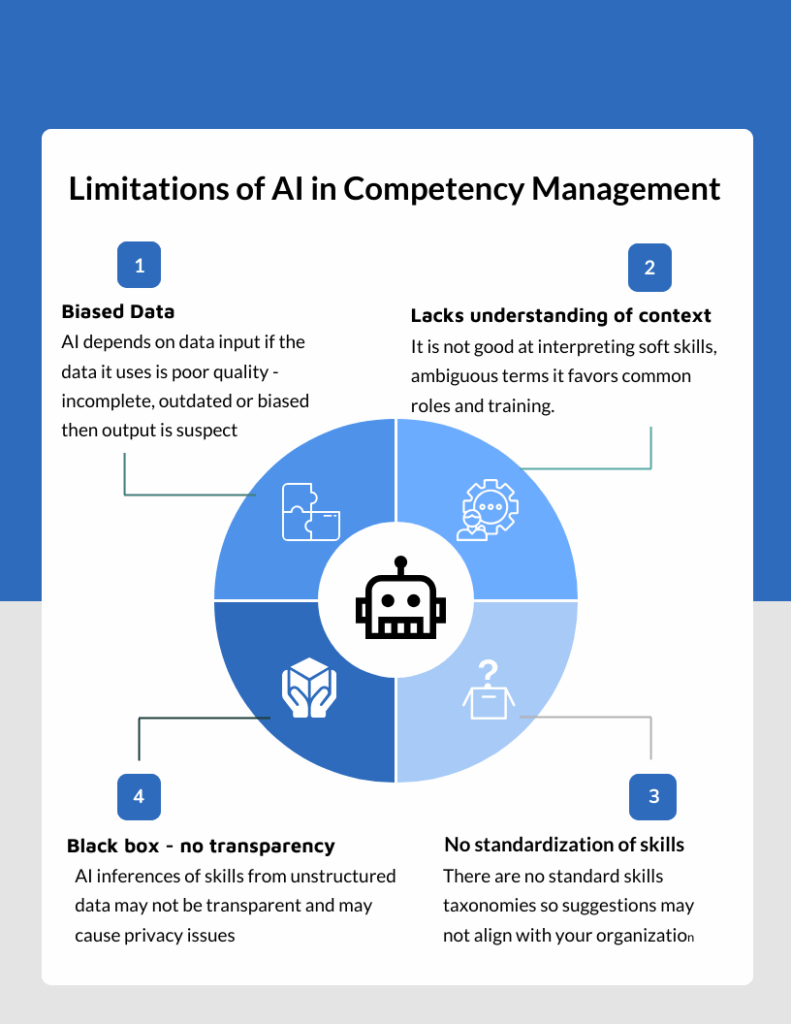
The Skills-Based Workforce
Building a skills-based workforce turns the idea of a skills-based organization into reality. It means identifying, validating, and using skills data to inform daily workforce decisions — from deployment and development to pay and performance. This guide outlines the practical steps to get there: creating a usable skills library, mapping skills to roles and competencies, using AI to infer skills from existing data, and applying that information to close gaps and plan reskilling. It highlights the safeguards needed to ensure accuracy and fairness, and the ways verified proficiency data can support capability growth and equitable reward.
What is a skills based work force?
A skills-based workforce is one where people are deployed, developed, and rewarded according to verified skills and competencies rather than static job titles. It shifts focus from hierarchy to capability — what individuals can do and how those abilities contribute to performance and organizational goals.
In this model, data on each employee’s skills and proficiency levels form the foundation for staffing, training, and succession planning. Instead of waiting for vacancies or restructures, managers can dynamically match talent to demand, accelerating project delivery and reducing idle capacity.
A skills-based workforce does not eliminate roles; it enhances them by providing visibility of transferable skills and development potential. The result is a more agile organization where learning, reskilling, and deployment decisions are grounded in evidence rather than assumptions.
What are skills?
The language of skills is often confusing — terms like capability, competency, and skill are used interchangeably when they describe different concepts. Without a clear conceptual ontology, any skills data will be inconsistent and unhelpful for decision making.
Capability refers to any factor that may contribute to successful performance at work. Education, qualifications, training, certifications, licenses, and professional memberships are all forms of capability — but they do not guarantee skill. They are evidence of exposure to learning or experience, from which we can infer, but not confirm, job-relevant skill.
Competencies combine knowledge, skill, and appropriate on-the-job application. A person is competent when they can apply their skills and knowledge effectively in the work setting.
Skill is the ability to perform an activity or task — often involving several steps — to a defined standard. It is a learned behaviour that develops gradually with practice. Learning theory identifies progressive stages of skill acquisition: from cognitive understanding, through guided practice, to autonomous performance. (Insert diagram here.)
Skill must be distinguished from knowledge. Knowledge is a prerequisite — for example, knowing the road rules before learning to drive. However, true competence is only demonstrated when that knowledge is applied consistently in real conditions.
Application matters because training transfer is imperfect. A significant proportion of knowledge and skills demonstrated in training environments are not automatically applied on the job. Competency management bridges that gap — linking capability evidence to demonstrated workplace performance.

Why implement skills/competency based management
Implementing a skills-based workforce provides a clear, evidence-driven view of what people can actually do — not just what their job titles or qualifications suggest. This visibility supports both strategic and operational decisions across recruitment, deployment, and development.
At a strategic level, skills data reveals strengths and gaps across the organization. Leaders can identify emerging capability needs early, prioritise training investments, and reduce dependence on external hiring. As new technologies and regulations appear, verified skills data enables rapid reskilling and redeployment without compromising compliance or quality.
Operationally, skills visibility transforms workforce planning. Managers can assemble teams based on proven proficiency rather than assumption, and staff can see the link between their skills, their development goals, and their career options. This transparency improves engagement, retention, and internal mobility — reducing the time and cost of filling capability gaps.
A skills-based approach also strengthens assurance. Many regulators and insurers now expect demonstrable evidence that staff performing safety-critical work are competent and current. Maintaining validated skills profiles allows organizations to show, at any time, that their workforce meets required standards.
Ultimately, the shift to a skills-based workforce aligns people, data, and performance. It builds resilience by turning individual proficiency into measurable, collective capability — ensuring that the organization can adapt confidently to change.
Make better decisions by using the whole range of capability, career interest and potential information.
How to implement skills based management
Transitioning to a skills-based workforce is not a quick reclassification of job titles — it’s the systematic integration of skills and competency data into your overall capability framework. The process follows seven key steps.
Step 1. Implement a Capability (not purely Skills) Management System
Begin by defining what information you need within your overall capability framework — not just skills, but also qualifications, experience, certifications, and other evidence of capability.
Create structured headings and subheadings for these dimensions and build your capability lists. Allow staff to add capability types not yet captured in your HR information system to their personal profiles.
This step establishes the data foundation for reliable analysis and audit.
Step 2. Define the Competencies Required for Successful Performance
Identify the competencies needed across different functions of the organization.
These may include technical or clinical skills, leadership and management skills, core behavioural competencies such as teamwork and communication, and values-based competencies that reflect your culture.
Determine whether proficiency levels are necessary — for example, higher levels for senior or specialist roles.
At this point you have distinguished between inferred skills (from capability data) and observable skills (within defined competencies), creating a complete view of both.
Step 3. Map Competencies into Requirement Profiles
Group related competencies into requirement profiles that serve different purposes — performance management, job or role definitions, career pathways, onboarding, or leadership development.
Profiles allow consistent comparison across staff and simplify updates as roles evolve. They also provide a structure for targeted assessment and development planning.

Step 4. Create a Catalogue of Learning Resources
Develop a learning resource catalogue aligned to each competency, ideally by proficiency level.
Include both formal and informal learning — courses, qualifications, on-the-job projects, and curated digital content.
This mapping connects development opportunities directly to assessed gaps and ensures learning activities contribute to measurable capability growth.
Step 5. Assess Current Competency Levels and Identify Gaps
Assign the appropriate requirement profiles to staff and conduct assessments using validated methods — observation checklists, knowledge tests, self-assessments, or 360° feedback.
The resulting data reveals both individual and organizational competency gaps.
Visualizing this information through dashboards or matrices highlights strengths, compliance risks, and development priorities.
Step 6. Plan and Track Competency Development
Use the assessment results to create and monitor individual development plans that:
- Build essential skills during onboarding or internships
- Close identified competency gaps
- Support progression and career advancement
- Prepare staff for new or evolving operational needs
- Link development objectives to measurable outcomes so progress can be tracked and reported.
Step 7. Use Capability and Competency Data to Inform Talent Decisions
Finally, integrate verified capability and competency data into all talent management decisions — from workforce planning and succession to pay, promotion, and redeployment.
This ensures that decisions are transparent, evidence-based, and aligned with organizational strategy.
A skills-based workforce is achieved when skills and competencies are continuously updated, validated, and connected to real business outcomes.
AI in Skills Managment
Artificial Intelligence can accelerate the process of building a reliable skills dataset by analysing existing information already held across HR, learning, and operational systems.
AI tools can scan job descriptions, CVs, performance notes, and learning histories to identify potential skills and group them into meaningful categories. This process reveals hidden strengths, duplicated roles, and opportunities for redeployment that might otherwise go unnoticed.
However, these AI-generated inferences are probabilities, not proof.
The model predicts which skills are likely present based on text patterns, but it cannot confirm proficiency, recency, or context. Without validation, inferred skills can quickly inflate an organization’s skill inventory and mislead decision-making.
To use AI responsibly:
- Treat inferred data as a starting point for human review.
- Validate each inferred skill through evidence — such as assessment results, certifications, or observed performance.
- Maintain audit trails showing how inferences were generated and approved.
- Ensure staff have visibility of what information AI has derived from their records and an opportunity to correct or verify it.

When combined with verified assessments and development tracking, AI saves time while maintaining data integrity.
It turns unstructured people data into structured insights — provided that governance, transparency, and human expertise remain central to the process.

Limitations Of AI in Skills Management
While AI can speed up the identification of potential skills, its results are only as reliable as the data and design behind it. Training data often contains bias, incomplete information, or outdated terminology — meaning that AI-generated skills may reflect patterns in historical data rather than current reality.
AI also lacks true contextual understanding. It cannot accurately interpret soft skills, teamwork, or leadership potential, and tends to favour frequently occurring job roles and training materials. This can disadvantage specialists or emerging professions.
Another limitation is interoperability: different AI systems use different taxonomies, so inferred skills may not align with your organization’s framework.
Finally, automated analysis of unstructured data must respect privacy boundaries and transparency standards.
AI adds value when used with governance, human review, and clear data standards — ensuring that automation enhances, not distorts, the picture of workforce capability.
Using skills data for decision making
Capability (competency and skills) data is central to workforce decision-making — supporting better hiring, development, deployment, and planning.
Better Hiring Decisions – Matching candidates to roles based on validated skills and competencies reduces hiring bias and improves job fit.
Internal Mobility and Retention – Skills visibility enables internal talent marketplaces, helping employees move into roles that align with their strengths and aspirations.
Personalized Development – Verified skills data enables targeted learning pathways, so employees acquire the specific competencies needed for career growth.
Workforce Planning and Succession – Aggregated skills data highlights gaps and emerging needs, supporting leadership pipeline development and strategic workforce shifts.
Equal Opportunity – Shifting focus from credentials and tenure to demonstrated skills creates fairer, more inclusive progression opportunities.
Critical Requirements for Reliable Decisions
However, these benefits depend on the quality and governance of your data.
Data Accuracy and Completeness – Skills databases must be actively maintained. Evaluations must distinguish between demonstrated and inferred skills, and competency definitions kept up to date with evolving organisational priorities.
Transparent Purpose and Acceptance – Employees are more likely to engage when the purpose of data collection is clear and visibly linked to career development and learning opportunities.
If skills data is also used for performance appraisal, research shows accuracy can decline without appropriate safeguards.
Focus on Functional Skills – Functional and technical competencies remain the strongest predictors of job success.
Soft skills, leadership potential, and cultural fit are valuable but harder to assess objectively; use these carefully, with complementary evidence sources.
With disciplined data governance, skills insights move beyond inventory tracking to drive evidence-based workforce planning, targeted development, and equitable talent decisions.
Skills-Based Pay — Potential and Pitfalls
Skills-based pay can motivate growth and recognize expertise, but only when based on validated competencies, not self-declared or inferred skills.
Poorly designed systems that assign “skill tokens” or automatic pay increments from unverified data risk inflating records, creating inequity, and disconnecting reward from actual job performance.
True value comes when pay progression is tied to demonstrated proficiency levels within a competency framework that is aligned with organizational goals, is transparent, evidence-based, and reviewed through consistent governance.
(See also: Problems with Skills-Based Pay for a detailed discussion.)
A skills-based workforce makes talent visible, development targeted, and decisions evidence-driven. When combined with competency data and verified capability, it becomes the foundation for a more adaptive, equitable and future-ready organisation.
Next steps
- Explore the Skills-Based Organization – how strategy and governance enable implementation.
- See AI in Competency Management – how automation supports skills discovery and validation.
- Return to the Capability & Competency Resources Hub
FAQ
What is a skills-based workforce?
A workforce managed through validated skills data that informs deployment, development and pay decisions.
How do you implement a skills-based workforce?
Create a skills library, map skills to roles and competencies, infer gaps with AI, and validate through assessments.
How can AI help identify skills?
AI analyses job descriptions, CVs and learning data to suggest likely skills, but results must be reviewed for accuracy.
Is skills-based pay reliable?
Only if proficiency levels are verified and governance prevents bias or outdated skill claims.
